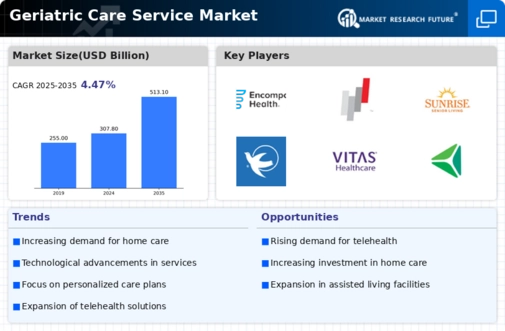Aging Population
The Global Geriatric Care Service Market Industry is primarily driven by the rapidly increasing aging population. By 2024, the global population aged 65 and older is projected to reach 1.5 billion, accounting for approximately 16 percent of the total population. This demographic shift necessitates a greater demand for specialized geriatric care services, as older adults often face complex health issues requiring tailored interventions. The growing prevalence of chronic diseases among the elderly further exacerbates this need, compelling healthcare systems to adapt and expand their geriatric care offerings. Consequently, the market is expected to grow significantly, reflecting the urgent need for comprehensive care solutions.
Government Initiatives
Government initiatives aimed at improving healthcare access for older adults are crucial drivers of the Global Geriatric Care Service Market Industry. Many countries are implementing policies that promote the development of geriatric care services, including funding for home care programs and incentives for healthcare providers to specialize in geriatric medicine. For example, the United States has introduced various programs under Medicare that enhance coverage for geriatric services. Such initiatives not only improve the quality of care for older adults but also stimulate market growth by increasing the availability and accessibility of geriatric services. This supportive regulatory environment is likely to foster innovation and investment in the sector.
Market Growth Projections
The Global Geriatric Care Service Market Industry is projected to experience substantial growth over the coming years. With a compound annual growth rate (CAGR) of 4.76 percent anticipated from 2025 to 2035, the market is set to expand significantly. By 2035, the market value is expected to reach 513.1 USD Billion, reflecting the increasing demand for geriatric care services driven by demographic changes and rising healthcare needs. This growth trajectory indicates a robust market environment, characterized by ongoing investments in technology, service innovation, and workforce development to meet the evolving needs of the aging population.
Increased Chronic Diseases
The rising incidence of chronic diseases among the elderly significantly influences the Global Geriatric Care Service Market Industry. Conditions such as diabetes, heart disease, and dementia are increasingly prevalent in older adults, necessitating specialized care services. According to estimates, nearly 80 percent of older adults have at least one chronic condition, which complicates their healthcare needs. This trend underscores the importance of geriatric care services that can provide comprehensive management of these conditions. As the population ages and the prevalence of chronic diseases rises, the demand for geriatric care services is expected to escalate, contributing to a projected market value of 513.1 USD Billion by 2035.
Technological Advancements
Technological advancements play a pivotal role in shaping the Global Geriatric Care Service Market Industry. Innovations such as telehealth, remote monitoring, and artificial intelligence are transforming the way geriatric care is delivered. For instance, telehealth services have expanded access to healthcare for older adults, particularly those in rural areas, thereby improving health outcomes. The integration of AI in care management systems enhances personalized care plans and optimizes resource allocation. As these technologies continue to evolve, they are likely to drive market growth, facilitating more efficient and effective care delivery for the aging population, which is projected to reach a market value of 307.8 USD Billion by 2024.
Rising Awareness of Geriatric Care
The growing awareness of the importance of geriatric care among families and healthcare providers significantly impacts the Global Geriatric Care Service Market Industry. As more individuals recognize the unique healthcare needs of older adults, there is an increasing demand for specialized services that cater to this demographic. Educational campaigns and community outreach programs are helping to inform the public about the benefits of geriatric care, leading to higher utilization rates of these services. This heightened awareness is expected to drive market growth, as families seek comprehensive care options for their elderly relatives, thereby contributing to the overall expansion of the geriatric care sector.
























Leave a Comment